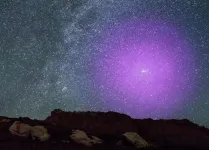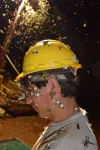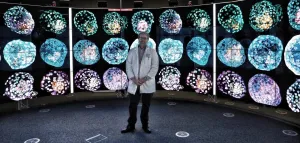Invisible dark matter and dark energy account for about 95% of the universe's total mass and energy, and the majority of the 5% that is considered ordinary matter is also largely unseen, such as the gases at the outskirts of galaxies that comprise their so-called halos.
Most of this ordinary matter is made up of neutrons and protons - particles called baryons that exist in the nuclei of atoms like hydrogen and helium. Only about 10% of baryonic matter is in the form of stars, and most of the rest inhabits the space between galaxies in strands of hot, spread-out matter known as the warm-hot intergalactic medium, or WHIM.
Because baryons are so spread out in space, it has been difficult for scientists to get a clear picture of their location and density around galaxies. Because of this incomplete picture of where ordinary matter resides, most of the universe's baryons can be considered as "missing."
Now, an international team of researchers, with key contributions from physicists at the U.S. Department of Energy's Lawrence Berkeley National Laboratory (Berkeley Lab) and Cornell University, has mapped the location of these missing baryons by providing the best measurements, to date, of their location and density around groups of galaxies.
It turns out the baryons are in galaxy halos after all, and that these halos extend much farther than popular models had predicted. While most of an individual galaxy's stars are typically contained within a region that is about 100,000 light-years from the galaxy's center, these measurements show that for a given group of galaxies, the most distant baryons can extend about 6 million light-years from their center.
Paradoxically, this missing matter is even more challenging to map out than dark matter, which we can observe indirectly through its gravitational effects on normal matter. Dark matter is the unknown stuff that makes up about 27% of the universe; and dark energy, which is driving matter in the universe apart at an accelerating rate, makes up about 68% of the universe.
"Only a few percent of ordinary matter is in the form of stars. Most of it is in the form of gas that is generally too faint, too diffuse to be able to detect," said Emmanuel Schaan, Chamberlain Postdoctoral Fellow in Berkeley Lab's Physics Division and lead author for one of two papers (https://journals.aps.org/prd/abstract/10.1103/PhysRevD.103.063513) about the missing baryons, published March 15 in the journal Physical Review D (view the other paper at this link: https://journals.aps.org/prd/abstract/10.1103/PhysRevD.103.063514).
The researchers made use of a process known as the Sunyaev-Zel'dovich effect that explains how CMB electrons get a boost in energy via a scattering process as they interact with hot gases surrounding galaxy clusters.
"This is a great opportunity to look beyond galaxy positions and at galaxy velocities," said Simone Ferraro, a Divisional Fellow in Berkeley Lab's Physics Division who participated in both studies. "Our measurements contain a lot of cosmological information about how fast these galaxies move. It will complement measurements that other observatories make, and make them even more powerful," he said.
A team of researchers at Cornell University, comprised of research associate Stefania Amodeo, assistant professor. Professor Nicholas Battaglia, and graduate student Emily Moser, led the modeling and the interpretation of the measurements, and explored their consequences for weak gravitational lensing and galaxy formation.
The computer algorithms that the researchers developed should prove useful in analyzing "weak lensing" data from future experiments with high precision. Lensing phenomena occur when massive objects such as galaxies and galaxy clusters are roughly aligned in a particular line of site so that gravitational distortions actually bend and distort the light from the more distant object.
Weak lensing is one of the main techniques that scientists use to understand the origin and evolution of the universe, including the study of dark matter and dark energy. Learning the location and distribution of baryonic matter brings this data within reach.
"These measurements have profound implications for weak lensing, and we expect this technique to be very effective at calibrating future weak-lensing surveys," Ferraro said.
Schaan noted, "We also get information that's relevant for galaxy formation."
In the latest studies, researchers relied on a galaxies dataset from the ground-based Baryon Oscillation Spectroscopic Survey (BOSS) in New Mexico, and CMB data from the Atacama Cosmology Telescope (ACT) in Chile and the European Space Agency's space-based Planck telescope. Berkeley Lab played a leading role in the BOSS mapping effort, and developed the computational architectures necessary for Planck data-processing at NERSC.
The algorithms they created benefit from analysis using the Cori supercomputer at Berkeley Lab's DOE-funded National Energy Research Scientific Computing Center (NERSC). The algorithms counted electrons, allowing them to ignore the chemical composition of the gases.
"It's like a watermark on a bank note," Schaan explained. "If you put it in front of a backlight then the watermark appears as a shadow. For us the backlight is the cosmic microwave background. It serves to illuminate the gas from behind, so we can see the shadow as the CMB light travels through that gas."
Ferraro said, "It's the first really high-significance measurement that really pins down where the gas was."
The new picture of galaxy halos provided by the "ThumbStack" software that researchers created: massive, fuzzy spherical areas extending far beyond the starlit regions. This software is effective at mapping those halos even for groups of galaxies that have low-mass halos and for those that are moving away from us very quickly (known as "high-redshift" galaxies).
New experiments that should benefit from the halo-mapping tool include the Dark Energy Spectroscopic Instrument, the Vera Rubin Observatory, the Nancy Grace Roman Space Telescope, and the Euclid space telescope.
NERSC is a DOE Office of Science user facility.
INFORMATION:
In addition to the lead authors from Berkeley Lab, UCB and Cornell, researchers from 41 institutions in seven countries participated in the new studies. The work was supported in part by the U.S. Department of Energy Office of Science, the National Science Foundation, Princeton University, the University of Pennsylvania, and the Canada Foundation for Innovation. Funding for the Sloan Digital Sky Survey IV has been provided by the Alfred P. Sloan Foundation, the U.S. Department of Energy Office of Science, and the Participating Institutions.
More
"Ancient light illuminates matter that fuels galaxy formation," Cornell Chronicle, Cornell University, March 15, 2021
Founded in 1931 on the belief that the biggest scientific challenges are best addressed by teams, Lawrence Berkeley National Laboratory and its scientists have been recognized with 14 Nobel Prizes. Today, Berkeley Lab researchers develop sustainable energy and environmental solutions, create useful new materials, advance the frontiers of computing, and probe the mysteries of life, matter, and the universe. Scientists from around the world rely on the Lab's facilities for their own discovery science. Berkeley Lab is a multiprogram national laboratory, managed by the University of California for the U.S. Department of Energy's Office of Science.
DOE's Office of Science is the single largest supporter of basic research in the physical sciences in the United States, and is working to address some of the most pressing challenges of our time. For more information, please visit energy.gov/science.





